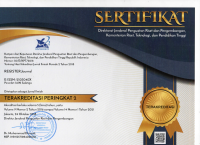Speaker-Dependent Based Speech Recognition
Abstract
This is the first part of the two parts of a qualitative focused R&D research aimed at designing an application to assist students with visual impairment (VI) in learning English writing and reading skills. The designed application was a speaker-dependent based speech recognition. Conducting alpha and beta testings, it was revealed that MAKTUM, the name of the application, exposed weaknesses on the selection of Ogden’s Basic English as the linguistic resources for the application and on the recording complexities. On the other hand, MAKTUM displayed strengths in individualized pronunciation and simple interfaces to operate.
Keywords
Full Text:
PDFReferences
Becker, W. (1977). Teaching reading and language to the disadvantaged—What we have
learned from field research. Harvard Educational Review, 47(4), 518-543.
Berger, A. & Constance R. K. (1970). Sources of Information and Materials for
Blind and Visually Limited Pupils. Elementary English, Vol. 47, No. 8 (December,
, pp. 1097-1105.
Borchers, J. O. (2001). A pattern approach to interaction design. Ai & Society,15(4), 359-376.
Bourlard, H. A., & Morgan, N. (2012). Connectionist speech recognition: a hybrid
approach (Vol. 247). Springer Science & Business Media.
Craig, R. D., & Jaskiel, S. P. (2002). Systematic software testing. Artech House.
Dorman, D. (1995). Technically Speaking: Products for the Blind and Visually Impaired.
American Libraries, Vol. 26, No. 11 (Dec., 1995), pp. 1143-1144.
Flesch, R. (1944). How Basic is Basic English?. Harper’s Magazine, 188(1126), 339-343.
Freeman et. al. (2007). Care of the Patient with Visual Impairment (Low Vision
Rehabilitation). American Optometric Association.
Galiano, Anna. R & Portalier, S. (2011). Language and Visual Impairment: Literature
Review. International Psychology: Practice and Research. Vol. 2.
Galitz, W. O. (2007). The essential guide to user interface design: an introduction to GUI
design principles and techniques. John Wiley & Sons.
Garcia-Valderrama, Teresa & Mulero-Mendigorri, E. (2005). R&D Management 35, 3,
Blackwell Publishing.
Kashdan, S. & Barnes,S. (2002). Teaching English as a New Language to Visually
Impaired and Blind ESL Students: Problems and Possibilities. Kaizen Program for
New English Learners with Visual Limitations.
Mahdjoubi, D. (2009). Four Types of R&D. Presentation Paper. University of St. Edward. Texas
Malinowski, B. (1994). The problem of meaning in primitive languages.Language and
literacy in social practice: A reader, 1-10.
Malone, S. (2007). Mother Tongue-Based Multilingual Education: Implications for
Education Policy. Proceeding of he Seminar on Education Policy and the Right to
Education: Towards More Equitable Outcomes for South Asia’s Children Kathmandu,
-20 September 2007
Mayer, D. J. & Gaschke, Y.N. (1988). the Experience and Meta-Experience of
Mood. Journal of Personality and Social Psychology Vol. 55, No. 1, 102-111.
Pena, A. A. (1967). A Comparative Study of Selected Syntactical Structures of the Oral
Language Status in Spanish and English of Disadvantaged First-Grade Spanish
Speaking Children.
Santa A. A. (1991). Phonetic simplification processes in the* English of the Barrio:
Across-generational sociolinguistic study of the Chicanos of Los Angeles.
Shaffer,W.D., Squire, R.K., Halverson,R., Gee. P.J. (2004). Video Games and Future
Learning. Academic Advanced Distributed Learning Co-Laboratory. University of Wisconsin Madison: US.
Specia, L & Mihalcea, R. (2012, June). Semeval-2012 task 1: English lexical
simplification. In Proceedings of the First Joint Conference on Lexical and
Computational Semantics-Volume 1: Proceedings of the main conference and the
shared task, and Volume 2: Proceedings of the Sixth International Workshop on
Semantic Evaluation (pp. 347-355). Association for Computational Linguistics.
Templer, B. (2006). Revitalizing'Basic English'in Asia: New directions in English as a lingua
franca. TESL Reporter, 39(2), 17-33.
Templer, B. (2009). A two-tier model for a more simplified and sustainable English as an
international language. Journal for Critical Education Policy Studies, 7(2), 187-216.
Webb, S. (2006). Can ICT Reduce Social Exclusion? The Case of an Adults’ English
Learning Programme. British Educational Research Journal Vol. 32, No. 3, June
, pp.481-507.
Wild, T. A., Hilson, M. P., & Hobson, S. M. (2013). The Conceptual Understanding of Sound
by Students with Visual Impairments. Journal Of Visual Impairment & Blindness,
(2), 107-116
Zworykin, V. K. & L.E. Flory. (1947). an Electronic Reading Aid for the Blind.
Proceedings of the American Philosophical Society, Vol. 91, No. 2 (Apr. 5, 1947), pp.
-142.
DOI: https://doi.org/10.18326/rgt.v9i1.1-12
Refbacks
- There are currently no refbacks.
Copyright (c) 2016
License URL: https://creativecommons.org/licenses/by-sa/4.0/










